Fireplaces on biofuel: device, types and principle of action of bio-fireplaces
According to the proverb, a “living" fire is one of the phenomena that each of us is ready to admire endlessly. But if in a private house it is really possible to arrange a real wood hearth, then in an apartment you can only count on its electric analogue with an imitation of flame.
But that was before biofuel fireplaces entered our lives. Consider the principle of operation of these devices and several nuances that are important in the selection and further operation.
The content of the article:
How does a bio fireplace work?
Unlike wood foci, eco-fireplaces have a more decorative function - although heat is generated when a flame burns, it is not enough for full heating of the room.
Biological devices do not need a chimney, exhaust hood and other additional elements that threaten to turn the installation of an accessory into a new repair.
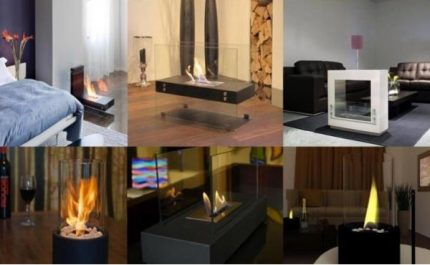
They work on liquid fuel, which gives a beautiful fire with even “tongues” of the flame.
Instrument Design Features
Ecofireplace is a fairly simple device that consists of three main components - a fuel block, a burner, and a body made of non-flammable material (usually glass, heat-resistant plastic or metal). Most often, devices also have a backlight, a protective screen and a flame control regulator.
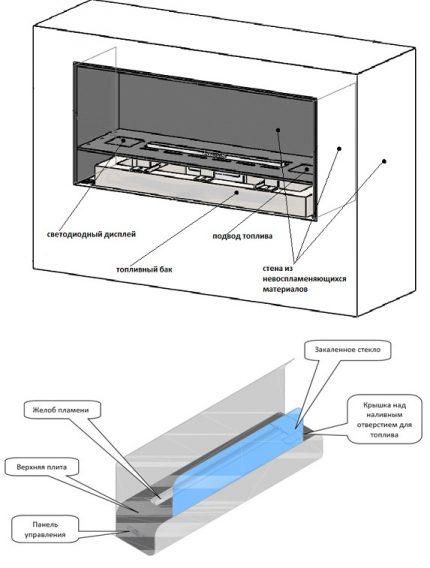
Automated systems are also equipped with a remote control unit to control the device from a remote control, mobile phone or tablet.
As well as many nice additions, for example:
- LED informative display, which displays data on the current state of the device, possible breakdowns, the presence of fuel in the tank;
- automatic ignition and extinction;
- cooling system with integrated fan;
- sensors for monitoring temperature, fuel and even carbon dioxide and humidity in the room;
- child lock function;
- the ability to connect to Wi-Fi and the systemSmart House».
The principle of operation of the device is as follows: the fuel is poured into the tank or an open container, the burner is ignited and “gives out” the flame until the fuel is consumed. But a lot depends on the technical equipment of the fireplace.
Simple appliances will require “manual” ignition and control of the flame level in the burner. You will also have to extinguish the fire yourself - using a special poker or damper.
To start / stop the automated fireplace, just turn on the corresponding button on the control panel.
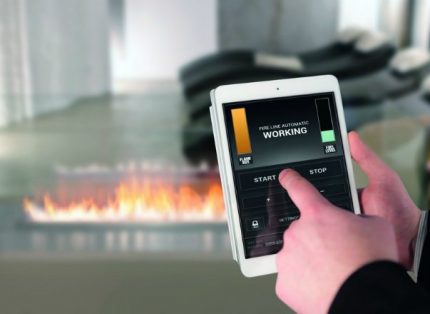
The specifics of the operation of the device is that the tongues of flame are not formed directly from the combustion of fuel, but only from its vapors, which are supplied to the burner through the outlet channel. And since the fire burns without smoke and smell, there is no need to build exhaust ducts, and the heat generated by the device remains completely in the room.
But, despite the high coefficient of efficiency, it will not work to use ecofireplace as the main source of heating - the power is not the same.
An important component of the device is decorative elements. Typically, these are ceramic products, stained glass, pebbles, mirrors and other refractory materials, with the help of which the device can both reliably depict a classic hearth and become the trendy highlight of the urban interior.
Advantages and disadvantages of eco-fireplaces
Unlike wood and gas fires, most biofireplaces (except for built-in) are mobile devices and have small dimensions.
Therefore, they can be installed in almost any room of the house and even taken out into the open air - for example, a terrace, a balcony or a house adjoining territory in a summer cottage.
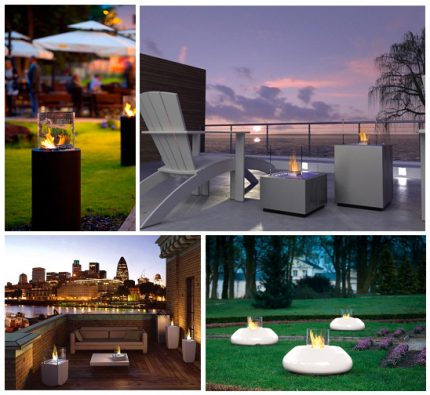
Advantages of the device:
- Versatility - there is no such interior where the home fireplace with beautiful flame petals does not fit.
- Easy installation - the device can be built into furniture or purchased a mobile structure, in any case, the installation does not require special knowledge and skills.
- Easy operation - biofireplaces will not require maintenance of chimneys, laundering multi-layer soot, harvesting firewood and other labor-intensive care. In order for the hearth to work, it is enough to fill it with special fuel on time and periodically clean the burner with a soft cloth.
- No need to apply for installation permission - for the installation of the bio focus, it will not be necessary to engage in long-term negotiations with the fire inspectorate and other services, as with the installation of a gas or wood counterpart. It is enough to observe safety rules when choosing a place and the subsequent operation of an open fire, and there will be no complaints from the regulatory authorities to you.
- Beneficial effects on the psyche - “live” flame is associated with warmth and tranquility, it relaxes and sets you up for relaxation, which is not the last thing with the bustling rhythm of modern life.
As for the minuses, the most global of them is the impressive cost of both the equipment itself and biofuel, the reserves of which have to be constantly replenished. But if you are willing to pay for the opportunity to decorate your interior with a spectacular highlight - consider the options for various models.
Classification of biofuel fireplaces
There are a lot of eco-fireplaces on the modern market, so even the most fastidious customers will not have problems choosing the right shape, design and color scheme.
But the choice of the device should be based not only on the effective form, but also on the availability of free space, because it is one thing to purchase a compact mobile device that can be moved or hidden if necessary, and the stationary center with a portal is quite another.
By installation method
In the simplest version, a biofireplace is a small desktop device that can be placed on any horizontal surface, the main thing is that it be sufficiently stable and wide. Its main advantages are mobility, compactness, low fuel consumption and affordable price.
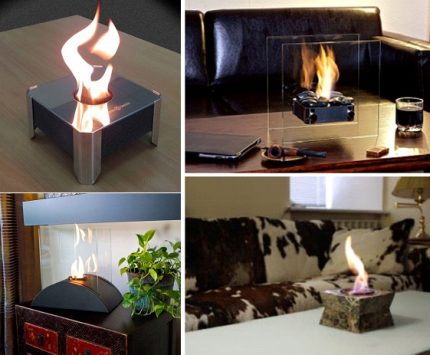
Wall-mounted - devices with a closed back wall (sometimes ends) and a transparent facade. They are most similar to the classic fireplace portals, but can be decorated in both historical and modern styles.
Such devices will not take up much space, since they are closely leaning against a wall or other vertical surface.
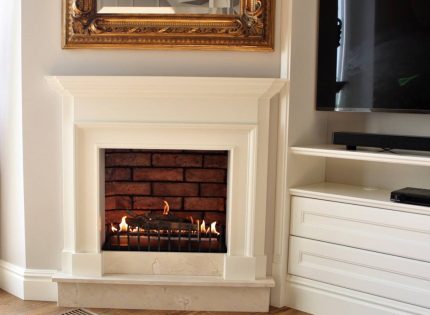
Freestanding - beautiful, spectacular, but quite dimensional devices that will be more appropriate in spacious rooms, although you can choose a rather compact rectangular model if you wish.
Such devices allow you to admire the fire from all sides, for which the case is most often made of transparent thermoplastic or glass, and can be moved using roller wheels built into the foot.
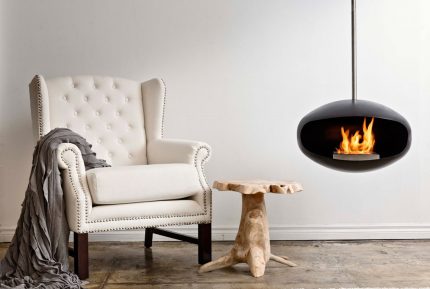
Recessed - appliances that can be installed in any niche of a suitable size, whether it is a wall, floor, column or recess in furniture.
Depending on the destination, you can choose a device with a vertical or horizontal burner.
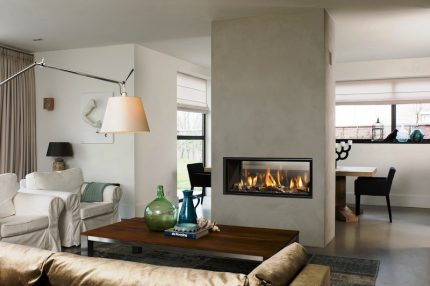
Street fireplaces can be distinguished as a separate subgroup. Such devices are most often mobile, so that you can rearrange them in any convenient place and clean the room during bad weather. But there are also stationary models built into the walls of houses, pedestals or pedestals.
Outdoor fireplaces are more suitable for commercial use in restaurants or entertainment centers, although they can also be installed in the adjacent territory. Their "trick" - enhanced protection against moisture and unexpected fire extinguishing by wind or rain.
This can be a special burner design, supplemented with absorbent fibers, or a collapsible housing with the ability to open / close the lid or raise the walls.
According to the shape of the body
Most often, a fireplace burner is enclosed in rectangular or square body. This allows you to more compactly position the device and give maximum similarity to a conventional firebox.
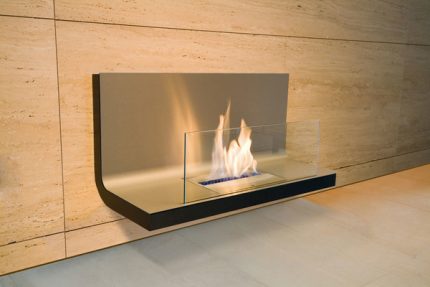
But there are other options:
- Corner fireplace - the triangular shape will allow you to install the device in any free angle, which is very convenient for small rooms.
- Fire line - A fashionable novelty with several fuel blocks and a narrow burner, the length of which can reach 1.5 meters.It looks especially impressive on the bar, in the wall niche or on the floor podium.
- Ball - a spherical fireplace can be suspended or floor, but in any case it will not go unnoticed.
- Candle or torch - narrow devices with a rectangular or cylindrical body and a powerful column of flame are in demand in modern interiors and landscape design.
- Open fire - in some models, the flame is not enclosed under the dome of the case, but only enclosed with protective glass around the perimeter or only from the front side. It looks, of course, spectacular, but the fire hazard of the device is significantly increased.
Compact devices designed for tables or other surfaces in the "medium height" area attract attention due to the original decor. The burner used here is the most common, most often round, so the emphasis is on non-standard design. It can be a plate filled with small pebbles or a beautiful glass from which the flame breaks out.
What to look for when choosing?
Although most often buyers are guided by the appearance of the device and its compliance with the interior design, do not lose sight of the technical characteristics of the device.
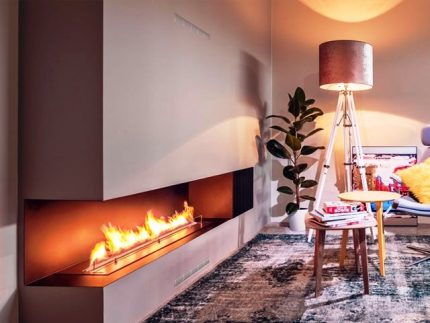
Important parameters:
- Biofireplace power - varies from 1 to 7 kW. The higher this indicator, the greater the heat transfer from the device will be, as well as the brighter the flame and the higher the column of fire. But the consumption of expensive fuel increases proportionally.
- Fuel tank capacity - from 50 ml to 9 liters. Of course, a device with a capacious capacity lasts longer without refueling, but since it is not recommended to leave unspent liquid in the device, it is worthwhile to estimate the real time of operation of the fireplace before buying.
- Burner material - for safe operation of the device, this element should be made of quality stainless steel 3-5 mm thick or ceramic.
- Double circuit burner - provides additional thermal insulation and controls the fuel level. For example, if you pour a lot of fuel, its excess will "go" to the second circuit and will be consumed only after the combustion of the liquid in the first.
But the fuel consumption, which is often of interest to buyers, is a very arbitrary value, because a lot depends on the power of the device, the size of its tank and the given flame force. For an hour, a medium-sized fireplace can consume from 350 ml to 1 liter of a combustible mixture, which is why many manufacturers indicate either a “plug” in flow rate or the minimum required to start.
What is biofuel?
For the use of eco-fires, special combustible compounds obtained from processing biological waste or made on the basis of plant materials. It gives a beautiful “living” flame without sparking, smells, soot and smoke.
The most common type of fuel is denatured ethanol. In addition, it is enriched with special additives that color the fire in a warm orange color.
And for those who want to enjoy the full illusion of a campfire with the characteristic crackling of firewood, there are special biogels that include sea salt.
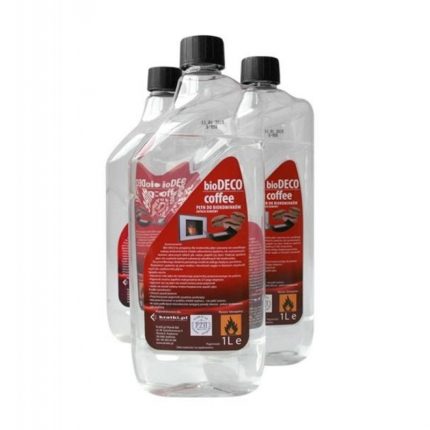
Industrial eco-fuel should contain at least 95% bioethanol, 3-4% water and 1-2% various additives (for example, methyl ethyl ketone or Bitrex) that prevent the mixture from splitting into water and alcohol and give a beautiful flame color.
In order to choose the right fuel for your fireplace, focus on the heating performance of the fuel (on average, about 6.5 kW / h of heat is generated during the combustion of 1 liter) and the presence of a quality certificate.
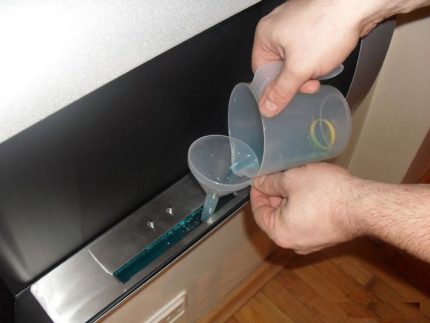
But if you wish, the mixture for refueling can be done with your own hands.
To do this, you will need:
- Purified 96 percent ethyl alcohol with a colorless flame - 1 liter.
- Gasoline with a high octane rating, for example, “Kalosha” (a simple car will not work - a characteristic odor will be emitted during combustion) - 50 ml.
- Aromatic additives from essential oils (optional) - 5-7 drops.
Then you need to mix the liquids in the indicated proportions, shake until a homogeneous mass is obtained and pour into the burner or fuel block.
The disadvantage of this method is that the combustible composition is suitable for use only immediately after preparation, making a supply for long-term storage will not work - the mixture will delaminate.
Read more about the types of fuel for a biofireplace in this stuff.
Rules for the safe use of a biofireplace
Although manufacturers have tried to make the device as safe as possible for home use, there is still a certain list of rules that it is important to observe the owners of eco-fireplaces.
The simplest thing is not to leave the working hearth unattended and not to install it near flammable objects, for example, near curtains, under hangers with clothes, wooden or plastic shelves and flammable accessories.
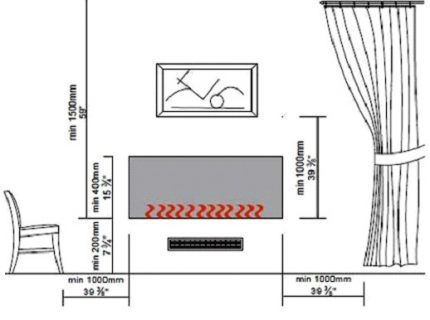
In addition to the obvious rules, there are specific nuances, for example:
- Install the device only on a reliable and as even surface as possible to prevent accidental tipping over (by the way, expensive devices have a special evenness sensor that can help determine the surface curvature no worse than the building level).
- Pour biofuel only into a cooled, non-working device and never replenish supplies during the combustion process.
- If the fuel mixture spills during refueling, immediately wipe this place dry to avoid self-ignition.
- Use only heat-resistant accessories, such as stones, metal, glass or ceramic imitations, for decoration.
- Control the fuel level in the tank and try to fill the liquid exactly for one use, otherwise the remaining ethanol will poison the air in your home with its vapor.
- To light a fire, use a special metal lighter for fireplaces with a long handle.
And the last thing - do not forget about ventilation. Although a biofireplace does not require an extract and does not evaporate harmful substances, carbon dioxide is released during the burning of any flame.
Be sure to ventilate the room after using the appliance and replenish the burned oxygen supply.
Conclusions and useful video on the topic
To navigate the upcoming choice, we suggest you look at a few reviews about the design of bio-fireplaces and evaluate how they look in the interior. And for craftsmen who are used to working with their own hands - a small bonus on the method of manufacturing a homemade device.
In this video you can clearly see the principle of action of a simple bio-fireplace:
What to look for when choosing a device:
How to make a burner for a biofireplace yourself:
And if there is a desire to save on an expensive purchase, make the housing and burner quite feasible and do it yourself. But if you want your fireplace to work in accordance with all safety rules, contact the professionals who will help with the selection of the model and its installation.
Still have questions about the topic of the article? Or found flaws in the material presented? Leave your comments, share experiences, ask questions in the block below.

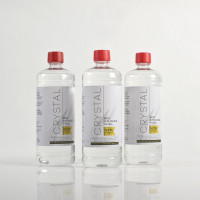 Biofuel for the fireplace: types of biofuel, its properties + how to choose and how to do it yourself
Biofuel for the fireplace: types of biofuel, its properties + how to choose and how to do it yourself 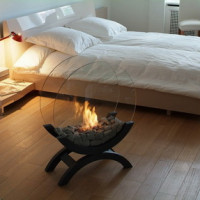 How to make a bio fireplace with your own hands: device, diagrams and step-by-step assembly instructions
How to make a bio fireplace with your own hands: device, diagrams and step-by-step assembly instructions 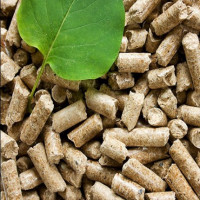 Types of Biofuels: Comparison of Solid, Liquid, and Gaseous Fuels
Types of Biofuels: Comparison of Solid, Liquid, and Gaseous Fuels 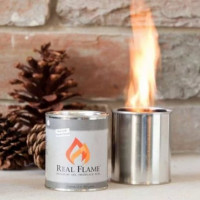 How to choose fuel for a biofireplace: a comparative overview of the types of fuel + analysis of popular brands
How to choose fuel for a biofireplace: a comparative overview of the types of fuel + analysis of popular brands 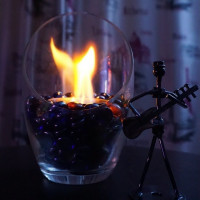 DIY bio-fireplace burner: instructions and manufacturing tips
DIY bio-fireplace burner: instructions and manufacturing tips 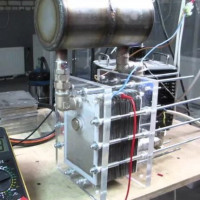 How to make a hydrogen generator for your home with your own hands: practical tips for manufacturing and installing
How to make a hydrogen generator for your home with your own hands: practical tips for manufacturing and installing 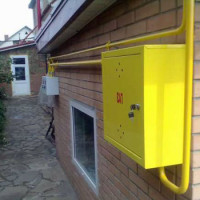 How much does it cost to connect gas to a private house: the price of organizing gas supply
How much does it cost to connect gas to a private house: the price of organizing gas supply  The best washing machines with dryer: model rating and customer tips
The best washing machines with dryer: model rating and customer tips 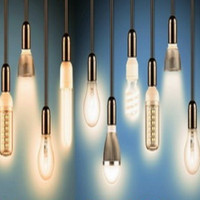 What is the color temperature of light and the nuances of choosing the temperature of the lamps to suit your needs
What is the color temperature of light and the nuances of choosing the temperature of the lamps to suit your needs 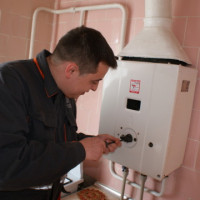 Replacement of a geyser in an apartment: replacement paperwork + basic norms and requirements
Replacement of a geyser in an apartment: replacement paperwork + basic norms and requirements
Fire is always fascinating. It seems to me that the fireplace in the house will always be a relevant object, and will become popular all the time. Now everyone is opting for bio-options due to operational safety. They are in no way inferior to traditional fireplaces in design and attractiveness, now even their eyes are scattered from the variety of their shapes and decor.
I have a small desktop bio-fireplace, I just use it for beauty and putting my nerves in order. It is on ethanol, such fuel is consumed economically, in itself inexpensive. Everyone can afford it. But such a fireplace does not heat at all. If you need not only beauty, but also warmth, you need to purchase large models that are expensive in price and service. It would be wiser to buy an electric fireplace.
Even a small bio-fireplace gives heat. Of course, it will not heat the room on its own, but when it is on I turn off the thermostat on the battery, otherwise it becomes stuffy.
It seems to me that almost everyone dreams of having a fireplace. At least, I have had such thoughts since childhood. The country house was perfect for implementing the plan. Biofuel fireplaces are now in demand, and the price is quite reasonable. Only now I advocate the standard option. In fact, a biofireplace is a glass with burning alcohol. Here the feeling of magic disappears.
For those who want to build an ordinary brick fireplace. The simplest order.